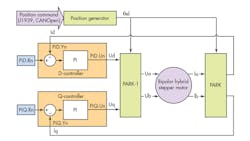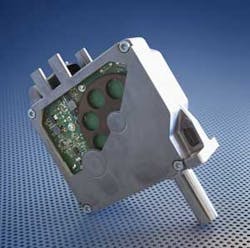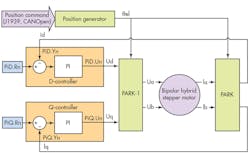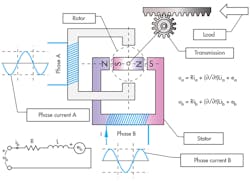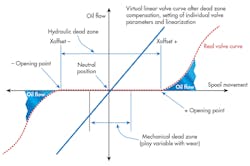Smart Actuation of Pumps and Valves
The trend in today’s mobile hydraulic system design is to use electrohydraulic proportional valves to transmit only enough engine power to drive the specific loads for a job. Because it is not practical to control valves sized for flow rates of 50 l/min (13 gpm) or more directly by proportional solenoids, pilot stages come into play. The pilot stage taps into a machine’s main hydraulic system for pressurized fluid to provide the force needed to control position of spools in large valves.
This file type includes high resolution graphics and schematics when applicable.
Pilot stages typically require an oil pressure of 20 to 30 bar (about 300 to 400), which must be maintained at all times as long as the machine is operating—even if the operating hydraulics are not in use. Moreover, pressure fluctuations in the system, contamination in the oil, and high viscosity of oil at low temperatures can have a direct negative effect on the operation of the pilot stage and, therefore, the hydraulic system’s controllability and efficiency.
In some instances, the need for a pilot circuit arises when some valve blocks consist of both mechanical valves and solenoid valves. For example, simple tractors may use mechanical valves as well as an electrically actuated load lift valve. This mixing of valve types can introduce incompatibility issues, as mechanical valves generally do not have ports for a pilot circuit.
The question then becomes how to operate large hydraulic valves (flow to 120 lpm at pressure to 250 bar) without having a pilot circuit. Furthermore, the operator must also account for pressure fluctuations caused by load and environmental conditions, such as temperature. A solution for many applications could be the S42 smart actuator, from Sonceboz Corp., Sonceboz-Sombeval, Switzerland.
An alternative valve actuator
The S42 is a mechatronic actuator using a hybrid stepper motor with integral electronics that can be operated via a CAN bus. It delivers sufficient force to actuate the main spool of the hydraulic valve directly, thereby eliminating the need for a pilot stage. So the smart actuator makes the hydraulic system more efficient by not relieving the pump from having to provide pilot pressure at all times. And because the S42’s operation is purely electrical, accuracy and repeatability are independent of conditions affecting the hydraulic oil. Incorporating the S42 smart valve into a mechanical valve block is also simple because no extension of the system, such as pass-through holes for pilot pressure flows, is needed.
The smart actuator has been used in mobile hydraulic valves from Bucher Hydraulics for more than a year and are in work trucks manufactured by Daimler Unimog and agricultural equipment from Holmer Maschinenbau GmbH. Similar systems from Sonceboz based on hybrid stepper motors have been used since 1996 on valves for mobile hydraulics. Probably the best-known applications are hydraulic valves for front-end loaders on John Deere tractors. The experience gained from application with more than 1.4 million motors in the field led to the design, development, and refinement of the S42 Smart Actuator. The result is the latest generation of hydraulic valve actuators, which offer improved availability, greater functionality, and added machine operator comfort.
A closer look
The mechanical design of the Smart Actuator consists of a hybrid stepper motor suitable for operating in a high-vibration environment, a 2-stage gearbox that converts the rotary movement of the motor via a toothed rack into linear movement, the valve spool, and electronics for controlling the motor and providing an interface. The entire unit is contained within a sealed aluminum die-cast housing to tolerate high-vibration environments typically encountered in off-highway applications.
The use of a hybrid stepper motor means that positioning is precise and highly repeatable. Opening points are achieved within a linear resolution of 7 µm and do not exhibit overshoot characteristics found in conventional proportional solenoids. The 12-V version achieves a positioning response of 80 mm/sec whereas the 24-V version moves at up to 100mm/sec. This means that with acceleration ramps, responses as actuator can move from 0 to 7 mm in 110 ms or or less. What’s more, there is no time lag when a reverse movement is command.
The unit is compact, measuring only 108 × 95 × 41.2 mm (4.25 × 3.74 × 1.62 in.). A 4-pin plug connector is protection-rated to IP-6K9K and mechanically protected by the housing. Two versions (12 and 24 V) of electronic circuit boards are available, each with the relevant protective components against power supply inversion, overvoltage, and power spikes. A CAN bus interface to the J1939 protocol is available as standard. Other protocols or analog interfaces could be implemented with no change to the physical shell.
A powerful microcontroller manages stepper motor controls and signal processing. The vector control is clocked at 20 kHz to provide precise positioning through classic stepping and partial stepping operations. Furthermore the intrinsic stepper motor characteristics ensure precise positioning, high drive, and holding torque coupled with a moderate restoring force (detent torque). Intelligent sensorless evaluation of the various motor data, such as the back EMF, ensures secure and precise valve control. If the valve slide should stall, the actuator can no longer operate correctly and reports the fault to the microcontroller.
Two temperature sensors mounted at different locations provide real-time diagnostics through feedback to the control system. Actuator behavior adjusted for temperature can be saved in order to compensate for different valve characteristics at low temperatures. This operates the valve reliably and precisely at temperatures down to –40° C, despite the much higher viscosity of the hydraulic oil at such temperatures.
The software provides the flexibility to adjust valve parameters to a specific application. For example, the valve’s performance curve can be linearized or progressively reproduced in the actuator, eliminating the need to mechanically configure valve characteristics. This means hydraulic component manufacturers need not produce different variations of the same valve and end users do not need to account for multiple spare parts.
To ensure that the actuator achieves the required position, the electronics evaluate voltage and current signals from the actuator, thereby avoiding the need for a position feedback transducer. If the voltage and current readings indicate no movement of the stepper motor due to any cause, the fault is detected and reported to the controller.
Another benefit of the close interaction between software and hardware is represented by dead-band detection and the ability to save the slide coverage variation for each valve in the EEPROM on the actuator. This provides precise hydraulic valve control because error otherwise caused by mechanical production tolerances and mechanical play from wear can be compensated throughout the entire working life of the valve and the machine.
To accomplish this, every time the S42 smart actuator is powered on, the amount of play at the zero position of the valve slide is sampled up to the spring force on each side. The valve slide provides cover from this point until oil flow begins. This can be determined for each valve, for example on a test bench. The information is stored, then remains constant for the life of the valve.
Taken together, this results in a virtually complete linear curve while also ensuring that the control characteristics are identical and constant from valve to valve. These characteristics remain constant over time and reduce production costs because of relaxed tolerances for the slider cover without jeopardizing accuracy of valve control.
This file type includes high resolution graphics and schematics when applicable.
Applications for the S42 smart actuator are expected to grow well beyond those mentioned above. For example, one trend that can be foreseen is the growing requirement for SIL conformity.
For more information, contact the U.S. office of Sonceboz Corp., Ann Arbor, Mich., at (734) 622-0330 or visit www.sonceboz.com.
